Geoff Mead: Meet the Author of Bear Child
by Floris Books • 12 March 2018 • Bear Child, Geoff Mead, Sanne Dufft • 0 Comments
We’re hosting a blog tour to celebrate the launch of ethereal new picture book Bear Child. Join creators Geoff Mead and Sanne Dufft as they talk about their book across the blogosphere from 12th-18th March.
To kick off the blog tour, we chatted to author Geoff Mead about his life as an author and the story behind Bear Child.
You can follow the rest of Geoff Mead and Sanne Dufft’s #BearChild blog tour on Twitter.
Firstly, can you tell us a little bit about yourself?
You could call me a late starter. It took me a long time to discover that I could actually write stories. I’d written academic articles and non-fiction for years. Then, one day about 10 years ago, an idea came to me out of the blue. I sat down at the keyboard and three hours later a story had emerged. It was such fun that I’ve been writing them ever since.
I have four grown up children from my first marriage and five grandchildren ranging from 6 to 18 years old. They are my greatest fans and fiercest critics! I live in a small Cotswold village with my beloved Cockapoo, Ted (also known as Captain Midnight). We also spend a lot of time in Lyme Regis where I have a flat overlooking the bay. They are both inspiring places for a writer and his dog.
My working life is very mixed. I’m a writer, performing storyteller, freelance academic and leadership consultant. Somehow all these roles fit together quite well and keep me very busy. I feel very lucky to be able to earn a living by doing what I love.
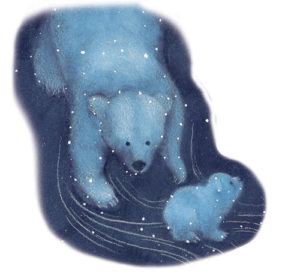
Where did you get the inspiration for Bear Child?
My wife Chris died three years ago, from the effects of a brain tumour. I wrote Bear Child as a gift for her when she was in hospital. Her lifelong love of bears and her own fiercely independent spirit were the inspirations for the story. The character of Ursula is exactly how I imagined Chris had been as a child. I took the idea of how the first bears came to earth from an old Ostyak myth and created the notion of them returning to the Great Bear when their time was done, because I wanted Chris to be able to turn to that image as she came to the end of her life. She died peacefully at home and Bear Child was one of the last things we spoke about.
Was writing the book helpful/therapeutic for you?
I was very happy to have written it. Chris loved the story and showed it to several friends. Six months after she died, we had a big celebration of her life, with art-making, music, poetry and storytelling. I recorded a version of Bear Child for people to listen to and that’s when I got the idea of publishing it as a book. The fact that it is now out there in the world means lot to me.
Why do you think we’re so fascinated by bears and bear stories?
People in every culture that has co-existed with bears have been fascinated with them. Bears are powerful, intelligent, curious creatures. They fear little and generally mind their own business unless disturbed. They are surprisingly human-like when they walk on their hind legs. So, they’re sometimes called King of the Mountain, Master of the Forest, or – my particular favourite – Old Man in a Fur Coat. There are still remnants of this close association in the English language despite the fact that native British bears became extinct 1,000 years ago: we bear heavy burdens, we bear down (and up), we bear in mind, we even bear children! 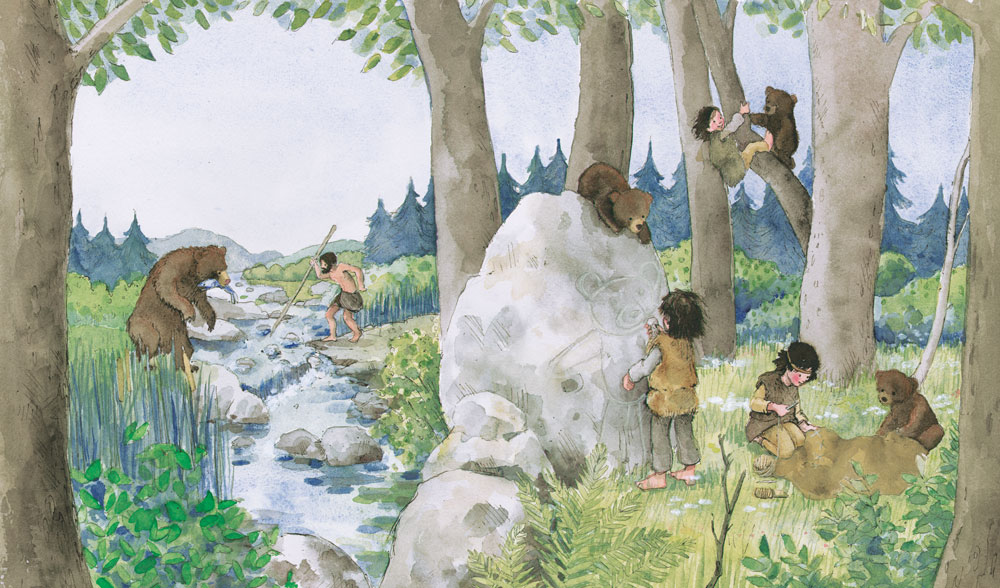
You’ve previously written a number of non-fiction books, memoir and poetry. How does writing a picture book compare?
All of these different styles require equal measures of inspiration and perspiration, and demand different techniques. But, I think the essence of all good writing is both simple and fiendishly difficult: get your ego out of the way and write what is true. It’s certainly what I tried to do with Bear Child. When Floris Books accepted the story for publication, I had to simplify some of the language to fit an audience of 4-7 year olds. Then, as Sanne Dufft produced her marvellous illustrations, I learned how much a picture can say without words and how the images and text have to dance to the same tune.
When not writing, you’re a Narrative Leadership Consultant. Can you explain what that involves? Storytelling and business aren’t two things that people would necessarily put together.
I work with a wide range of people in government, business, NGOs and charities as well as teaching on Master’s and Doctoral level programmes. Leadership is about many things but one vital aspect is helping to make sense of complex situations and communicating that to other people. Stories are simply the most potent and effective way of doing that. In an age when politicians claim ‘alternative facts’ and public discourse seems increasingly unconcerned with truth, understanding how stories work and telling authentic stories have never been more important.
You studied mediaeval history and then became a police officer – how did you get to your current role?
I never have been able to work out the segue from studying mediaeval history to joining the police! But in mid-career I got involved in leadership development as Director of the National Accelerated Promotion Scheme. That led to a deep interest in personal and organisational development and further study for a Master’s Degree and a PhD. I ‘discovered’ storytelling by chance about the time I retired from the police service in 2002, took a six month sabbatical and trained as a performing storyteller at the International School of Storytelling. Over the next decade and a half, alongside learning to write, I brought these interests together in an offering I call Narrative Leadership.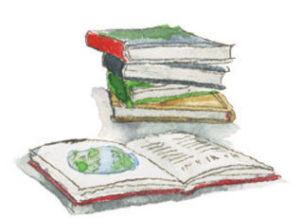
Storytelling is a common thread that runs through your life – what is it about storytelling that makes it so important/fascinating to you?
I think storytelling is close to the heart of what it means to be human. We construct our sense of self through the stories we tell ourselves about our lives; we connect with other people through the stories we share; we create stories to make sense of how the world works and our place in it. When it comes to fiction, we visit other worlds so that we may experience our own more deeply. In a way, we can only live the lives we can imagine. Degenerative storytelling limits us to narrow, stereotypical possibilities whilst emancipatory storytelling expands our potential. The character of Ursula in Bear Child for example, encourages girls to revel in their robust strength and to live bold and adventurous lives.
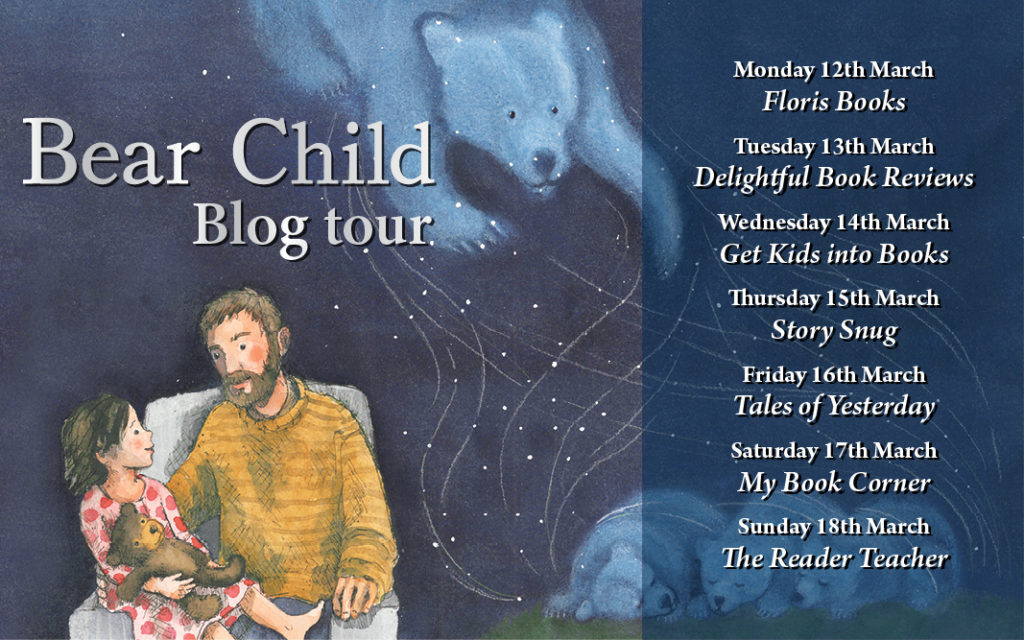
More about Bear Child and Geoff Mead
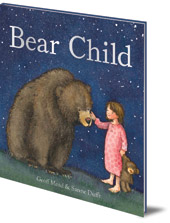 Who are the bear folk and what makes them special?
Who are the bear folk and what makes them special?
Bear Child is an inspirational story of parental love, belief and embracing individuality. This beautiful picture book weaves together Geoff Mead‘s charming words with Sanne Dufft‘s ethereal illustrations to create a truly timeless folktale.
Join Geoff Mead and Sanne Dufft on their #BearChild blog tour and let us know what you think on Facebook and Twitter!